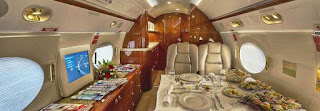The Turbo Station Airplane is one of the smaller ones for private flights.
https://centraljetcharter.com/turbo-stationair.html
THE TURBO STATIONAIR AIRCRAFT
Cost to Buy $525k.
Range: 703 nmi
Crew: One or two
Capacity: six passengers
Height 50 in (1.26 m)
Width 43 in (1.08 m)
Length 12 ft 1 in (3.68 m)
Rate $800 – $1,300/hr.
The Turbo Stationair Private Aircraft is designed to fit your mission needs. Choose from five different seating options designed for any mission. From the relaxing club seating to the one seat trainer configuration with a clear view of the instrument panel, each cabin configuration allows for maximum flexibility with seat tracks that run the length of the cabin.
THE TURBO STATIONAIR AIRCRAFT EXTERIOR
cessna Turbo Stationair exterior, private airplane charter
The Turbo Stationair Private Aircraft with the Venture Premium Interior Package you can choose from five spacious cabin arrangements, all fashioned with Light grey sidewalls with dark charcoal accents, punctuated by embossed graphic textures, and jade blue detailing, to create this bold interior. The seat upholstery, in two tone light grey with black bolsters, is covered in highly durable Luxor-Leather.
THE TURBO STATIONAIR AIRCRAFT INTERIOR
turbo stationair interior, turbo stationair cabin, turbo stationair inside, private aircraft charter
Enhanced situation awareness for pilots means enhanced safety for all.
The leading technology of the Garmin G1000 all-glass avionics suite integrates the functionality and reliability needed to fly with confidence.
The naturally aspirated model was equipped with the Continental IO-520A, and the Turbo model featured the TSIO-520-C, which was rated at 300 hp.
THE TURBO STATIONAIR AIRCRAFT INSIDE
Turbo Stationair inside, turbo stationair interior, turbo stationair cabin, private aircraft charter
The Turbo Stationair’s flight deck is a proven system that reduces workload with added features and capabilities.
It has graphical weather radar, electronic charts, Synthetic Vision Technology (SVT), engine sensor data, autopilot functionality, and more.
THE TURBO STATIONAIR AIRCRAFT CHARTER
turbo stationair cabin, turbo stationair interior, turbo stationair inside, Turbo Stationair aircraft
You have the option of showing the EVS feed on the MFD in large format, which is handy during approach.
Once on the ground, the view can be reduced and displayed beside the airport map to support ground navigation.
There is virtually no weight added to the Turbo Stationair with integration of the EVS, and its value in situation awareness is immeasurable.
THE TURBO STATIONAIR AIRCRAFT CABIN
turbo stationair interior, turbo stationair cabin, turbo stationair inside, private plane charter
Graphics modeling technology recreates a 3D virtual rendering of the surrounding landscape on both of the PFDs.
The resulting picture depicts a dimensional graphic of ground and water, airports, obstacles and air traffic all shown relative to the aircraft.
There was much talk about which airplanes would be revived and which would be left to history as Cessna modernized its airplanes and streamlined production.
TURBO STATIONAIR CHARTER FLIGHTS
turbo stationair interior, turbo stationair cabin, turbo stationair inside, Turbo Stationair Charter
The optional enhanced vision system (EVS) is a perfect complement to the G1000’s SVT, providing an infrared view outside the cockpit that turns night into day improves vision through smoke and haze.
The EVS provides a real-time moving image of the outside environment and illuminates possible hazards.
It became clear that Cessna was going to restart production of its piston lineup some 15 years ago.
TURBO STATIONAIR COCKPIT
Turbo Stationair Cockpit
Cessna built almost 6,000 206s from 1964 up until the company halted its piston production in 1986.
This is an impressive figure considering that during that time Cessna built tens of thousands of airplanes that competed for customers with the 206.
The Turbo Stationair private aircraft start’s at $700 per hour and up. The Turbo Stationair. https://centraljetcharter.com/turbo-stationair.html




WE can get the Turbo Stationair for your next trip.
ReplyDeletePlease contact us at any time for the Turbo Stationair.
ReplyDeletehttps://centraljetcharter.com/turbo-stationair.html
ReplyDeleteTurbo Stationair Airplane Charter
ReplyDeleteUnlike some of the airplanes, such as Otters and Caravans, that ply the same missions as the 206 does, the Stationair is a true light airplane.
Turbo Stationair Water Landing
Turbo Stationair water landing
It is powered not by a turboprop but by a conventional six-cylinder piston engine. Yet it's remarkably capable.
If you leave out some fuel, it can carry six adults, counting the pilot, and if you leave off some more fuel, it can carry a goodly amount of bags on top of that.
That's the story of the 206, getting things done and making money in the process.
Whether carrying commuters from Seattle to the islands, hauling fish in Alaska, transporting patients in the Outback of Australia or delivering food and medical supplies to indigenous people in the mountains of Ecuador, the 206 is a utility airplane in the true sense of the word.
Turbo Stationair Private Flights
Turbo Stationair exterior, charter flights
It's not an overstatement to say that it is still in production solely because of its utility.
Like any smart company today, Cessna is not in the business of building products for which there's not a demand. The 206 earns its keep.
The Turbo 206, with its big rear double doors and capacious cargo area, making it a great aircraft for air cargo.
Utility has been at the heart of the 206 story since it was born nearly 50 years ago.
The airplane, which started life as the U206, U standing for utility, never attracted a wide audience as a personal airplane.
The faster 210 had a solid hold on that market. The 206, on the other hand, offered a little more room, a little more power and a better useful load compared with the 182. And the 206 cost less to buy and maintain than the 210.